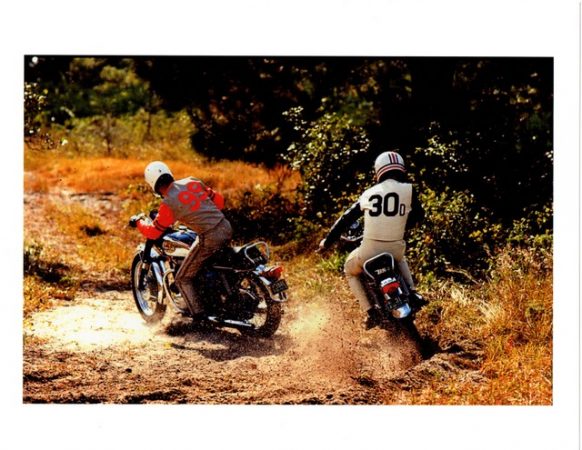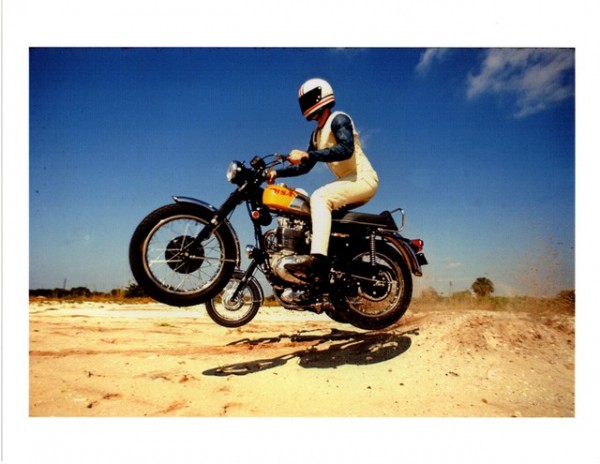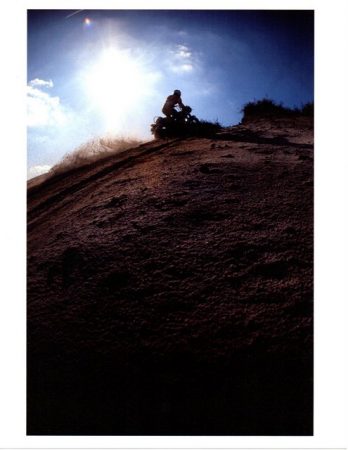
 Update: Donald L. Miller died Saturday (June 20, 2015) in New York City at the age of 83 after suffering a stroke. This column appeared last Sept. 16. It was a pleasure knowing him, hearing his stories and eating his scones, if only for a short while…
Update: Donald L. Miller died Saturday (June 20, 2015) in New York City at the age of 83 after suffering a stroke. This column appeared last Sept. 16. It was a pleasure knowing him, hearing his stories and eating his scones, if only for a short while…
Donald L. Miller has never owned a motorcycle. He’s never ridden one, either. But he does have vivid memories of days spent with BSAs and BMWs. There are photos of the Beezers and Beemers to prove it – carefully composed stills and compelling action shots that he took for advertising campaigns during a more than four-decade career as a professional photographer in New York City.
Miller also has one memorable studio shot of a voluptuous French lingerie model sprawled across a BSA. The bike was gift-wrapped; the model was naked, except for a red ribbon.
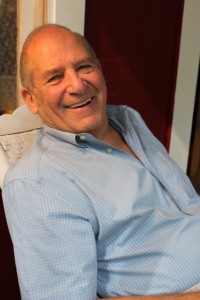 “I was in photography at exactly the right time – the heyday of advertising, the heyday of corporate and the heyday of magazines,” the 82-year-old Miller recalled during a kitchen table conversation recently at the getaway home in Falls Village that he’s owned for 26 years. His primary residence is in New York; a Central Park West apartment that he’s called home for 55 years.
“I was in photography at exactly the right time – the heyday of advertising, the heyday of corporate and the heyday of magazines,” the 82-year-old Miller recalled during a kitchen table conversation recently at the getaway home in Falls Village that he’s owned for 26 years. His primary residence is in New York; a Central Park West apartment that he’s called home for 55 years.
Miller specialized in pictures used in print ads – his work appeared regularly in “Fortune” magazine as well as in “Business Week” and “Forbes,” and in Time Life books. His many executive portraits appeared in annual reports. Yet he considered himself a generalist who took freelance assignments from ad agency art directors as they came in. He provided the artwork for ads for IBM, Univac, Traveler’s, Texaco, Gulf, and Shell.
It was a series of candid portraits of F-86 pilots taken during mission debriefings when he served in the U.S. Air Force in Korea in the early 1950s that gave him the necessary portfolio to launch a professional career. Discharged in 1955, he set up shop in 1957 and flourished during the “Mad Men”era of Madison Avenue when the country was experiencing cultural upheaval over the Vietnam War.
Miller stood out, and not only for his lens work. “I wore three-piece suits. I had short hair,” he said, adding that he smoked a pipe as well. “With my short hair and suits, the PR guys could bring me in to the chairmen without being embarrassed. I could talk civilized and act civilized.”
Consequently, he photographed top company executives from IBM, John Deere, PepsiCo, and J.C. Penney. “I was known for pleasant expressions. I was able to talk with these guys. Rather than have them stare into the camera, we talked. Usually I winged it, threw out trial balloons, and I got my expressions,” he explained.
Miller said that on only three occasions did he prep for a portrait shoot. Each involved a famous person – New York Yankees legend Joe DiMaggio, who was spokesman for the Bowery Savings Bank; banker and philanthropist David Rockefeller; and Egyptian president Hosni Mubarak.
In the case of Mubarak, he said, “I didn’t know what I was going to say until that morning.” A newspaper story reported that Mubarak has just attended baseball’s opening day with President George H.W. Bush, so he asked the Egyptian leader his opinion of the sport. “He said, ‘It’s a very boring game. I almost fell asleep.’” The question served its purpose of breaking the ice.
The assignment to photograph BSA motorcycles in the late 1960s came from an agency art director. “He wanted a new eye to see the bikes. He wanted someone to look at it differently,” Miller said. Having no experience with motorcycles, and not knowing much about them, was an advantage. “I was looking at them from a beauty and dramatic-image standpoint, and not from a technical standpoint,” he said.
The still pictures were shot in a New York studio and zeroed in on specific elements of the bikes, such as the knurled oil tank cap, a gas cap showing a reflection of the Union Jack, or a chromed shock absorber. “I didn’t have a set idea what I wanted to do,” Miller said, explaining that the images evolved as he looked through the viewfinder. “With each lens that I put on, I’d get an entirely different effect.”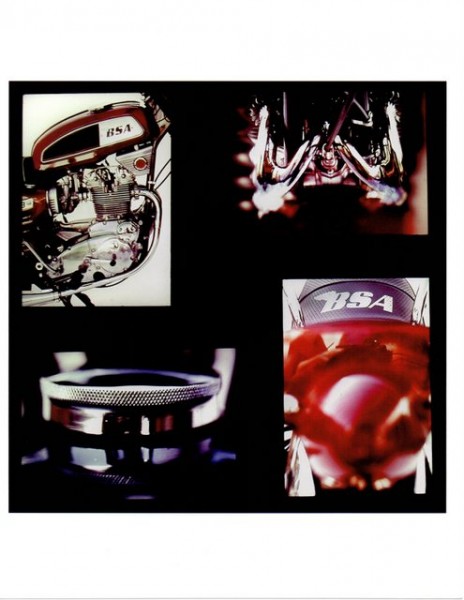
For BSA action shots, Miller went to West Palm Beach, Fla. where the company provided new bikes and riders from the factory racing team. They found some empty hills near the airport and put the bikes through their paces. “It was hot as hell that day but the adrenalin was flowing on everybody’s part. This was show time for them,” he said. By day’s end, the bikes were trashed. Mirrors were broken, gas tanks crushed, crash bars bent and spokes snapped. Miller had his pictures, though.
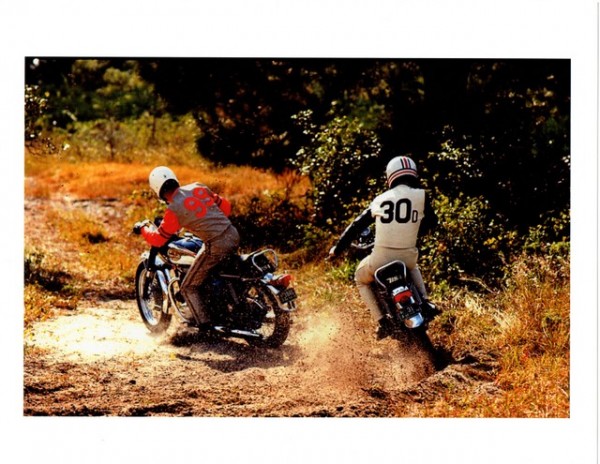 The pictures for a BMW print campaign required less strenuous activity. He lay in the rear of a station wagon and was driven down a road, followed by riders on BMWs. His pictures reflected “the comfort ride” that BMWs offered.
The pictures for a BMW print campaign required less strenuous activity. He lay in the rear of a station wagon and was driven down a road, followed by riders on BMWs. His pictures reflected “the comfort ride” that BMWs offered.
It was on a BSA, gift-wrapped in aluminum foil and tied up with a red ribbon for Christmas, on which the model reclined. She was regular visitor to Miller’s studio at 6th Ave. and 38th St. “She’d stop by the studio for a cup of tea and a cigarette. She’s come in and say, ‘It’s hot out there.’ She’d take her blouse off. She had this unbelievable attitude about taking her clothes off and not thinking about it,” he said.
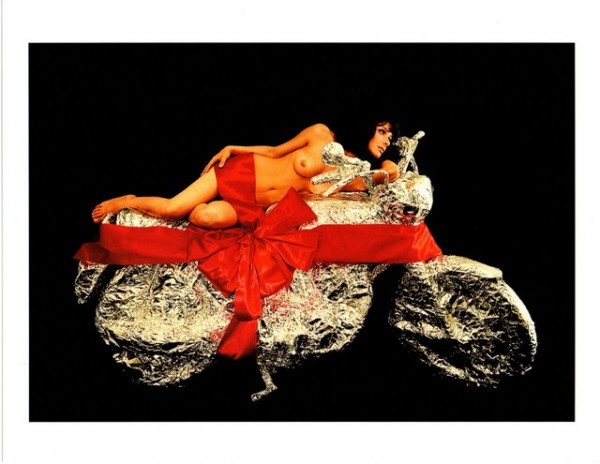 One day a BSA was there. “She comes in, looks at the set and said, ‘You have to take my picture on the motorcycle.’ That was that. She put her clothes on, she has a cup of tea, and she leaves,” Miller said.
One day a BSA was there. “She comes in, looks at the set and said, ‘You have to take my picture on the motorcycle.’ That was that. She put her clothes on, she has a cup of tea, and she leaves,” Miller said.
When it comes to taking pictures of motorcycles, or anything else, Miller advises amateur photographers to keep it simple and to go au naturel themselves by using existing light. “If you bring in spotlights, you create a shadow,” he said. It’s better to alter the light by moving around or by adjusting the subject. “You’re looking at the quality of light that’s hitting it, not the intensity,” he said.
Good advice. Just need a French lingerie model to try it out.
 Ride CT & Ride New England Serving New England, NYC and The Hudson Valley!
Ride CT & Ride New England Serving New England, NYC and The Hudson Valley!

